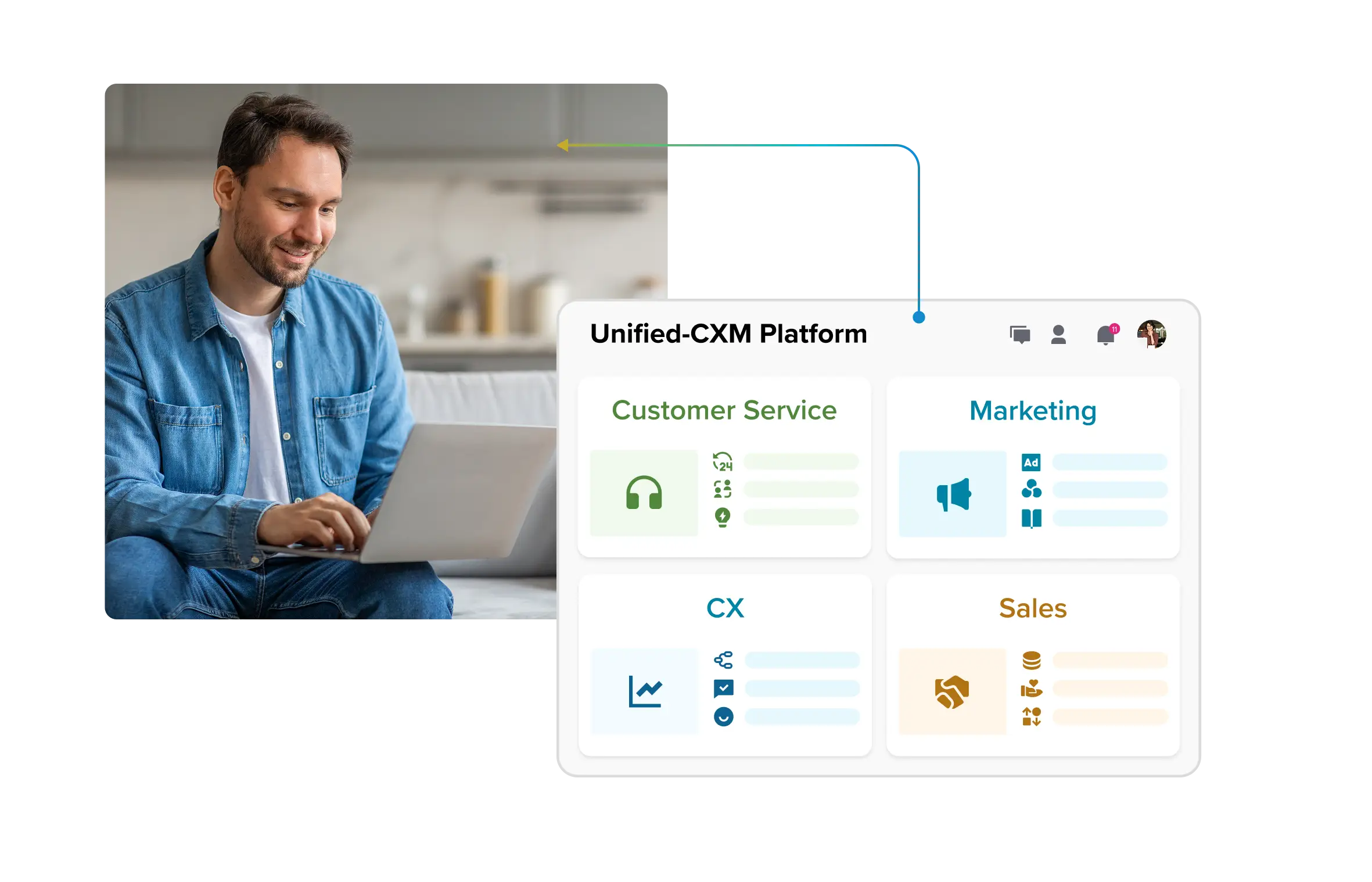The strategic AI-native platform for customer experience management
The strategic AI-native platform for customer experience management. Unify your customer-facing functions — from marketing and sales to customer experience and service — on a customizable, scalable, and fully extensible AI-native platform.

How to Evaluate Enterprise Grade RAG for AI Agents
Generative AI has rapidly moved from a novelty to a core enterprise capability. Forrester found that 67% of AI decision-makers plan to increase investment in generative AI within a year, underscoring its growing importance. In this context, Retrieval-Augmented Generation (RAG) which enriches large language models with up-to-date enterprise data is booming. Large Enterprises now see RAG as the key to unlocking relevant, trustworthy AI responses from their internal knowledge.
RAG works by taking a user query, retrieving relevant documents or data (from knowledge bases, files, product catalogs, etc.), and then feeding that context into an LLM prompt. This ensures responses are tailored by fresh enterprise data, reducing hallucinations and improving relevance. RAG can make AI Agents highly specific to a company’s products and policies, letting customer-service teams answer questions with precise, up-to-date information. In sum, RAG is widely embraced as a way to combine LLM creativity with internal knowledge, delivering more reliable and context-aware AI assistance.
The challenge of evaluating RAG systems
Yet as enterprises deploy more RAG-based agents, they face a hard truth: evaluating RAG quality is unsolved. Unlike traditional software, RAG pipelines have multiple components (indexing, retrieval, generation) and open-ended outputs, making testing difficult. This means that the gap between basic RAG implementation and enterprise-grade performance is wider than most organizations realize. Many teams can cobble together a basic RAG-based bot, but ensuring it consistently delivers accurate, grounded answers is hard.
In practice, quality checks are still mostly manual. Brands ask sample questions and eyeball the AI Agent’s answers. But experts warn this is grossly inadequate. Tapping a few queries for sanity-checking is like inspecting a skyscraper with a screwdriver. Obvious flaws might show up, but deep problems will be missed.
Without systematic evaluation, RAG Agents risk hallucinations, stale information, or irrelevant excerpts slipping through. Traditional approaches to testing (unit tests or fixed QA pairs) don’t scale. This bottleneck slows enterprise rollouts. Every change in data, retrieval settings, or prompts needs re-evaluation. Hence, having a quantifiable score on your RAG pipeline output is essential for improvement and trust.
Sprinklr’s Automated RAG Evaluation Framework
To solve this, Sprinklr has built an automated RAG Evaluation Framework directly into its platform. Instead of ad-hoc manual tests, Sprinklr’s framework lets brands systematically assess each RAG bot. Teams provide test cases (a user Question plus an Expected Answer). The platform runs the query through the RAG pipeline, capturing the LLM’s answer and the retrieved context for each test. It then computes a suite of metrics to quantify performance.
The idea is similar to recent RAG evaluation tools like RAGAS: automated tests that generate scores for retrieval and response quality. Sprinklr’s framework extends this concept in an enterprise-ready way. After a run, it produces a report showing:
- Overall Answer Accuracy
- Retrieval Quality
- Answer Relevance
- Groundedness for each test and dataset
With this report, teams can see immediately how well the AI Agent is answering questions and cite sources, and where it needs tuning or more data.
Evaluation methodology and metrics Sprinklr’s approach is founded on:
- Input: For each test, the user provides a question and an expected answer (the ideal or correct response).
- Execution: The system runs the question through the RAG pipeline. The Retrieval component fetches relevant document chunks from the indexed knowledge base. These are combined with the prompt and fed into the Generation Model (LLM) to produce an answer.
- Output: The framework collects the LLM-generated answer, the retrieved context chunks, and the user’s expected answer. It then computes a set of metrics that quantify quality.
Key metrics include:
- Overall Score: This measures how closely the AI Agent’s answer matches the expected answer. Sprinklr uses BERTScore, a semantic similarity metric based on transformer embeddings, to compare the candidate and reference answers. BERTScore goes beyond word overlap by looking at contextual similarity, giving a more robust assessment of meaning. A high BERTScore indicates the AI Agent’s phrasing and content align well with the expected answer. (In practice, the score can be averaged or thresholded to flag test failures.)
- Retrieval Quality: This evaluates how relevant the retrieved context was to answer the question. The system checks each retrieved chunk against the expected answer. Using a BERTScore threshold, it classifies chunks as relevant or not, then computes precision and recall of relevant chunks. In effect, this applies classic information-retrieval metrics: did we retrieve most of the needed information (recall), and did most retrieved data turn out useful (precision)?
- Answer Relevance: This is an LLM-judged metric. Sprinklr’s framework prompts the LLM to evaluate its own answer’s completeness, helpfulness and coherence relative to the query. For example, it might ask the model: “Does this answer fully address the question? Is it missing anything?” This yields a sub-score for how relevant and complete the answer is.
- Groundedness (Factual Accuracy): This metric checks whether the answer is supported by the retrieved context. Again, Sprinklr uses LLM evaluation: the model is asked if the answer’s statements are consistent with the source documents. In other words, did the answer correctly use the facts from the retrieved data, or did it hallucinate? Measuring groundedness — how much answers rely on actual retrieved content — is vital to trust. A high groundedness score means the response is factually supported by the context.
Internally, Sprinklr’s framework aggregates these into both detailed scores and a composite RAG Evaluation Report. Users can drill into each test case: seeing which relevant chunks were missed, how the answer scored on each dimension and where the model tripped up.
Key benefits
Embedding this automated evaluation delivers big wins:
- Faster time to deployment: Automated tests replace tedious manual QA. Teams can run hundreds of test queries in minutes and immediately see failures. This shortens test cycles dramatically. Sprinklr’s solution gives that automation natively in the platform, so quality checks happen continuously.
- Higher-quality RAG agents: With numeric scores, improvement becomes measurable. For example, comparing the groundedness score or answer relevance across model versions helps pick better prompts or document sources. Having a quantifiable RAG score “gives you the basis for improving” the pipeline, for example, by comparing different models, tuning prompts or optimizing retrieval. Sprinklr teams can thus boost RAG Agent’s quality in a data-driven way, not by guesswork.
- Continuous monitoring: The framework isn’t just for initial testing; it can be run continuously as data changes. This means Sprinklr customers can set up alerts if scores drop (e.g. a new knowledge base has errors), enabling proactive fixes.
Overall, this rigorous evaluation process helps teams identify weak spots and fix them before going live. It makes each bot’s capabilities transparent and testable.
Towards trustworthy Agentic AI in CX
In an era where enterprises build AI-driven customer experiences, trust and quality can’t be an afterthought. Retrieval-Augmented Generation offers the promise of smarter, data-rich agents, but only if we can guarantee their answers. Sprinklr’s automated RAG evaluation framework brings that rigor: it turns a formerly manual bottleneck into a continuous, measurable process.
Looking ahead, such systematic evaluation, including Generation and Evaluation of Test Sets, and Real-time Monitoring of AI Agent’s responses will be essential to the future of AI in customer experience. This is a part of the wider Single-click Auto-evaluation Framework being developed by Sprinklr to ensure that AI Agents don’t just speak fast but speak right.
Rigorous evaluation is the foundation of trustworthy, enterprise-grade AI, and will be a competitive differentiator for any organization that relies on automated customer engagement. For more information, book a call with a Sprinklr expert today.










